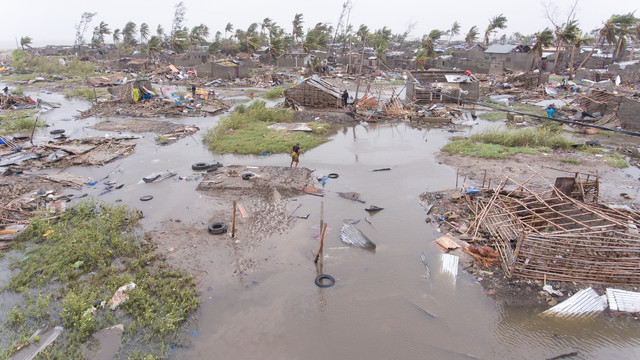The climate crisis and the fastest societal change, ever
‘Keeping 1.5 alive’ is going to take a monumental effort. Clare Shakya and Andrew Norton discuss factors that could drive the political ambition desperately needed for governments to keep the Paris Agreement’s most critical target in sight and deliver on climate finance promises long overdue.



Soil erosion caused by the floods at Gerua in Assam, India in September 2020. Climate impacts will worsen unless the world takes urgent action (Photo: Indian Red Cross Society, via Flickr, CC BY-NC 2.0)
Global carbon emissions, having dipped in 2020 due to the pandemic, by 2021 had almost rebounded to pre-pandemic levels.
The steep decline in global emissions to stay within 1.5oC – net zero by 2050 but also vitally 45% of 2010 levels by 2030 (according to the IPCC Special Report on 1.5°C) – has not yet started.
Going into COP26, the best assessments were that even if countries delivered everything they submitted in their mitigation plans, the planet would be on track for 2.5°C of warming this century. COP26 ended with a call for all countries to raise their level of ambition and commitment to ‘keep 1.5 alive’.
Where is the momentum going to come from?
The G7 must raise its game
The G20 account for 80% of global emissions − so their leadership is central. But the G7 countries (all having made different levels of commitment to reach net zero emissions by mid-century) need to create space for wider leadership too.
Costa Rica and Denmark launched the ground-breaking Beyond Oil and Gas Alliance at COP26. Some least developed countries (LDCs) have shown that leadership: Nepal joined The Gambia and Bhutan in making near-term net zero commitments – but as the LDCs and low-income countries increase their ambition, can we increase our support to these nations to mount pressure on the big emitters?
China, India, Indonesia and Brazil can only be shamed so far into stepping up. It is the G7 that must raise their game – by setting out concrete plans to reach net zero well before 2050. This is what we really need to increase political ambition.
Pockets of promise
There are some promising signs. Germany’s net zero target is 2045, while the UK has set a target into law to cut emissions by 78% by 2035 against 1990 levels.
Political deadlock in the United States Senate is preventing the federal government from moving forward with the most important elements of Joe Biden’s plans to combat climate change that were part of his presidential campaign.
But much can be done at state level when progress at national level slows – such as giving California and other progressive states the political, policy and financial space to drive change.
New leadership could emerge this year. Elections in Brazil and Australia could heavily influence levels of ambition, potentially leading to new and enhanced Nationally Determined Contributions (NDC) brought to COP27 in Sharm El-Sheikh.
Germany, with its new leadership declaring greater ambition on climate action, could also bring change in the G7 as the group’s new president. Indonesia produced a disappointing NDC for Glasgow, failing to raise ambition from its 2015 plan. But there is real hope it will come back this year with an improved plan, driven in part by new initiatives to support a just transition away from coal power.
There is also expectation that Turkey will bring forward an ambitious NDC – to date held up by its delayed ratification of the Paris Agreement.
Money matters: sharpening the focus on accountability
Delivering quality climate finance is also vital for rebuilding trust and to ensure no one can use lack of trust as an excuse to avoid the need for ambitious leadership. It is also vital for the poorest countries to be able to transform their societies, avoid losing development gains and avoid falling into ever greater debt.
All governments must be held to account for their climate finance plans and pledges; delivering fair shares of emission reduction and fair shares of climate finance is essential.
Every citizen needs to know their country’s per capita emissions compared to others so we focus our attention on the right places. It is natural to zero in on the G20’s big emitters that appear to have less ambitious emissions reduction targets. But China and India’s per capita emissions are so much smaller than those of the US.
We also need to use a greater range and number of tools. Even if we get the political ambition for countries to raise the headline numbers in the revised NDCs they bring back to COP27, the speed of delivery of policy and finance could well be too slow.
Corporates and investors representing US$130 trillion of investment ramping up their commitment in Glasgow could move the real economy ahead of where governments are.
If, for example, 50-60% of the corporates buying products from China asked their suppliers to drastically reduce emissions by 2030, that could have greater impact on China’s real economy than the pressure that would result from the US stepping up to deliver Biden’s original plan.
We need to focus on accountability of corporates and investors – and require they include value chain – or ‘Scope 3’ – emissions and 2030 targets if their plans are to be credible. Citizen action will be fundamental to positive change in public or private spheres, through social mobilisation and demanding rapid and transformational change as voters, consumers and investors.
There is also a limit to how much climate finance can be raised feasibly – the politics will never align with what is truly needed. As the frequency and intensity of climate shocks increase at pace, the major challenge will be getting sufficient finance to countries who are experiencing loss and damage and increasing poverty, while seeing their debt mount up.
But the courts offer another avenue. And a few more landmark cases could change attitudes by putting pressure on polluters and complicit governments alike.
Can more be done to set out the costs facing the poorest countries and those most vulnerable to climate change – can the courts tackle the politics of the countries and corporates feeling the heat of liability?
Keeping the heart of Paris beating
We know every increment of warming will drive suffering on a huge scale. Concluding the Glasgow climate conference, COP26 president Alok Sharma spoke in stark terms of the Paris Agreement’s most critical target, saying ”we have kept 1.5 degrees alive, but its pulse is weak”, and this week he highlighted the danger that promises made in Glasgow could “wither on the vine”.
Sharma was referring to the long-odds bet that governments climate commitments in 2022 will be significant enough to shift the dial meaningfully in time for COP27 in Egypt.
It will take imagination, solidarity, energy and courage to lower the odds on that bet through the course of the year. Business as usual will not cut it.




